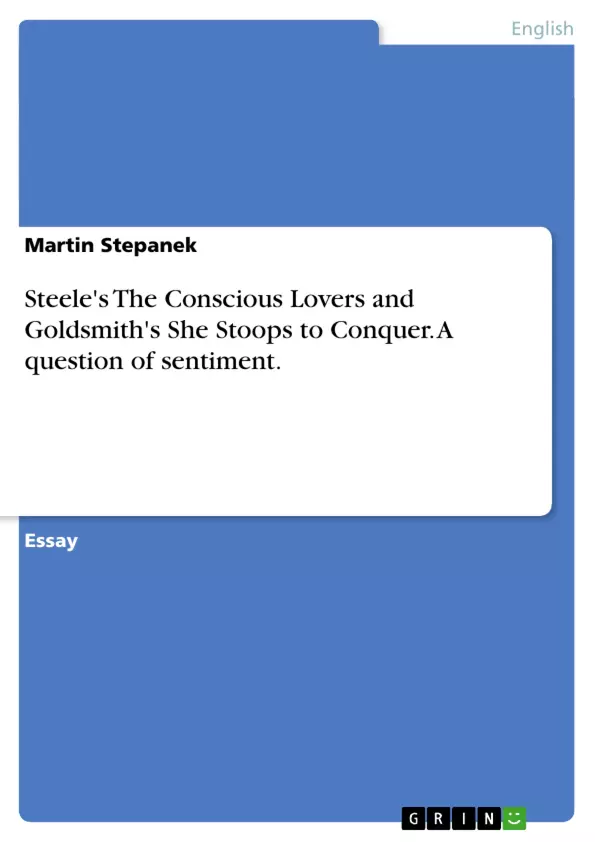The period from 1700 to 1790 is often referred to as the Age of Sentimentality. Steele (1672-1729), one of the most popular and controversial figures of this time, not only gained reputation as a dramatist, but also as a co-founder (with Addison) of the highly popular periodical The Spectator, in which questions of manners and social conduct were discussed, as well as moral issues and literature. His comedy The Conscious Lovers, which appeared at stage for the first time in 1722 and remained very popular throughout the following decades, was seen as a model for a new type of comedy, called ′Sentimental Comedy′.
Unlike Steele, who is one of the most prominent representative of the early decades of Sentimentality, Goldsmith (1730-1774) celebrated his finest literary success at the end of the sentimental period. When his comedy She Stoops to Conquer gained immediate appraisal on stage in 1773, the Age of Sentimentality already was in decline. How far Goldsmith and his comedy can be regarded as ′sentimental′ or ′anti-sentimental′ will be one question I would like to deal with in my essay.
The two authors, or rather their most important plays, are very interesting for they reflect, to some extent, the beginning and the end of Sentimentality and therefore provide us with an interesting insight into society, or rather the literary conception of society of that time.
Inhaltsverzeichnis (Table of Contents)
- Steele's The Conscious Lovers and Goldsmith's She Stoops to Conquer.
- A Question of Sentiment.
- Sentimental Comedy and its Critics
- The Conscious Lovers: A Comedy of Virtue
- Bevil Junior: An Exemplary Hero
- The Perfect Character: A Question of Reality
- The Sub-Plot and Secondary Characters
- The Importance of Tears
Zielsetzung und Themenschwerpunkte (Objectives and Key Themes)
This essay explores the evolution of sentimental comedy in the 18th century, focusing on two key plays: Richard Steele's The Conscious Lovers and Oliver Goldsmith's She Stoops to Conquer. It examines the influence of sentimentality on theatrical practice and social values, contrasting the contrasting approaches of Steele and Goldsmith to this emerging literary trend.
- The rise and decline of sentimental comedy in 18th-century England
- The influence of moral and social concerns on dramatic writing
- The portrayal of virtue, emotion, and social decorum in comedy
- The contrasting styles and themes of Steele and Goldsmith
- The impact of sentimental comedy on theatrical conventions and audience expectations
Zusammenfassung der Kapitel (Chapter Summaries)
- The first chapter introduces the concept of sentimentality in 18th-century literature and its impact on dramatic writing. It provides context for the rise of sentimental comedy, highlighting the works of Steele and Goldsmith as representative examples.
- The second chapter focuses on the development of sentimental comedy, discussing the critical responses to earlier Restoration comedies and the emergence of a new form of comedic writing that emphasized virtue and emotional engagement.
- The third chapter explores Steele's The Conscious Lovers, analyzing the character of Bevil Junior as a model of virtue and the play's exploration of social hierarchies and familial relationships.
- The fourth chapter examines the character of Bevil Junior in greater detail, discussing the challenges of portraying a perfectly virtuous hero and the potential for audience skepticism regarding his unrealistic behavior.
- The fifth chapter analyzes the role of the sub-plot and secondary characters in The Conscious Lovers, highlighting the use of humor and contrasting characters to create a balance between sentimentality and entertainment.
- The final chapter examines the emotional impact of Steele's play, particularly the use of tears as a means of expressing emotion and engaging the audience on a deeper level.
Schlüsselwörter (Keywords)
This essay explores key themes of sentimental comedy, including virtue, emotion, social decorum, and the contrasting styles of Steele and Goldsmith. It examines the impact of moral and social concerns on dramatic writing, focusing on the plays The Conscious Lovers and She Stoops to Conquer. Key concepts include the evolution of theatrical conventions, audience expectations, and the portrayal of exemplary characters.
- Quote paper
- Martin Stepanek (Author), 2000, Steele's The Conscious Lovers and Goldsmith's She Stoops to Conquer. A question of sentiment., Munich, GRIN Verlag, https://www.grin.com/document/9633



